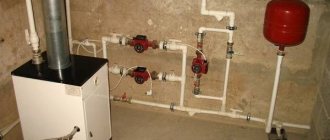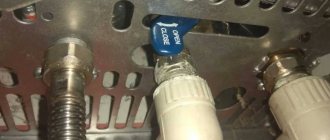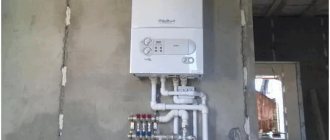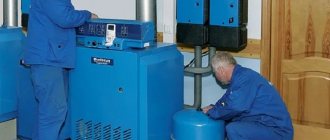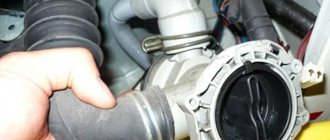Natural gas continues to be the most profitable coolant, and a gas boiler is the most convenient equipment for heating a private home. Owners of gas boilers have at least once encountered or heard about such an unpleasant phenomenon as spontaneous extinguishing of a gas boiler.
And although the automation of modern devices excludes the supply of gas when the burner flame disappears, the house cools down quite quickly in winter. In the absence of owners, the water in the pipes of the heating system may freeze, which will lead to catastrophic consequences. Therefore, if you observe episodic or regular extinguishing of the boiler, you need to find out the reason and find a way out.
Why does a gas boiler go out?
Unfortunately, calling a gas service technician is not always convenient, and sometimes you have to wait a long time for his visit. However, there are a number of cases when you can fix the problem yourself. In other situations, on the contrary, even a visit from a professional will not save you - if the culprit is the weather with strong squally winds or improper design and placement of the gas outlet pipe.
Review of manufacturers
Gas services, as well as experts in this field, recommend using boilers from the company. The units are presented in several versions and differ in functional features. Boilers are produced only of floor type.
The main difference from other analogues is the affordable price and the lack of electricity required for operation.
Keber boilers are also popular; they are equipped with an automatic safety and regulation system, which ensures precise gas supply and temperature stabilization.
Gas boilers of the AOGV series are quite in demand and are used to heat rooms that have a water heating system with natural or artificial circulation.
(Termotechnik) presents a large selection of boilers and offers floor-mounted, parapet-type, gas and solid fuel units. Many years of experience ensures excellent quality and guarantees product reliability and long service life.
Eliminating problems associated with blowing out the boiler requires special care and responsibility. It is necessary to check all components of the boiler to determine and eliminate the cause of the malfunction. If the recommendations presented do not bring results, it is worth calling the gas service specialists. Remember that quickly getting rid of problems will prevent additional breakdowns and protect not only the entire system, but also the residents of the house.
Watch the video in which a specialist examines one of the most common reasons: why a gas boiler goes out in the wind, what needs to be done, what work needs to be done to improve draft in the boiler:
In modern living conditions, gas boilers are considered the most economical type of autonomous heating systems. This equipment is quite simple to install. These boilers are easy to operate. However, the gas unit is engineering equipment, which means it fails. The most popular and common malfunction that owners encounter is self-extinguishing burners. In this article we will try to figure out why a gas boiler goes out and how to fix it.
Clogged igniter and burner nozzles
Natural gas, which runs in household pipelines, is not a 100% pure substance - it contains additives and impurities. Some of them are added intentionally (for example, to create a specific “gas smell”), others are formed as a result of careless cleaning.
And the gas itself (a mixture of methane and in small quantities - propane, butane and ethane) does not burn without a residue - hours of operation of the burner generate soot and soot, which gradually settles on the boiler parts and can lead to clogging and clogging of thin channels and holes - jets , through which gas is supplied to the igniter and the burner itself.
An atmospheric boiler igniter is a special device that allows a small flame to burn. When the gas supply is turned on cyclically, it is the gas that ignites the mixture supplied from the burner. A constantly burning “wick” smokes even more than a burner, since the pressure in the igniter is low. If soot clogs the pilot nozzle, the boiler will not be able to turn on the next time.
A sure sign of clogging and sootiness of the igniter is the yellow color of the flame. Therefore, the igniter must be cleaned in a timely manner to prevent the channel from blocking.
Burner nozzles become clogged much less frequently, since gas is supplied there under pressure in large portions, but this situation cannot be completely excluded.
Expert opinion
Filimonov Sergey Vinokurovich
Heating equipment repairman
If you decide to clean the jets yourself, be careful. The fact is that the nozzle channels are made of relatively soft metals - copper or brass. Using steel wire or a brush can damage the equipment. Use copper wire or a brass brush.
Common Causes of Attenuation
Often the boiler flame goes out due to lack of oxygen. Inexpensive models without a special hood that enhances traction are especially susceptible to this. The main cause of this problem is a clogged chimney or foreign objects getting into it.
Exit – the smoke exhaust pipe must be carefully cleaned. The draft will improve and the flame will burn well.
Insufficient natural gas pressure
Any boiler can go out if the gas pressure at the inlet drops.
The cause of the problem may be either in the gas main (wait until the gas workers fix it) or in the internal network.
Gas leakage through joints in pipes. If the joints of pipes and appliances become leaky somewhere, the leak needs to be found (especially if the smell of gas appears).
It is necessary to treat all potentially dangerous areas with soap foam using a sponge. Foam will bubble at the source of the leak. It is better to entrust this problem to specialists.
Poor ventilation or one of the sensors is faulty. Temperature and leakage sensors monitor the atmosphere near the boiler: what is the concentration of gases and whether it is too hot. Either there is a failure in one of the sensors, or the room is poorly ventilated.
Exit – open the door or window. If the flame is restored, then additional ventilation is needed. You can make a window at the bottom of the door, covered with a mesh with small cells.
The counter is faulty. If the meter deteriorates, it will not pass gas in sufficient volume. Symptoms of counter problems:
- Noise, crackling, other extraneous sounds;
- On the scale of the counting mechanism, the numbers do not change smoothly, but in jerks.
The solution is to call the gas workers. Doing anything with the meter yourself is prohibited by law!
Problems with the chimney
Weather conditions – rain, wind, low atmospheric pressure, high humidity. Weather conditions can cause underdraft, excess draft and reverse draft. As already mentioned, rain or strong winds may blow into the chimney. The problem can be solved by using a protective device at the end of the pipe or increasing its length.
How to correctly calculate the height of the pipe on the roof:
- On a flat roof pipe = 50cm.
- The pipe is closer than 1.5 m to the ridge or parapet = 50 cm above the ridge/parapet level.
- The pipe is at a distance of 1.5-3m. from the ridge = at the same level as the ridge.
- Further 3m. from the ridge. A horizontal line is mentally drawn from the top of the skate and lowered by 10 degrees. The top of the pipe should coincide with this line.
Permissible chimney elevations above buildings
Excessive draft may occur if smoke exhausters, fans, or additional ventilation ducts are installed.
However, there may be other difficulties with the pipe:
- Ice formation. The culprit is condensation. Little by little it accumulates and becomes so thick that it greatly interferes with traction. The solution is to knock off the ice that has already formed. And to prevent the situation from repeating itself, the chimney needs to be better insulated (then the moisture will not freeze, but will flow down into a specially made container - a sump at the bottom of the pipe).
- The pipe burned out. Check the chimney if the chimney is old. The only solution is to completely replace the pipe.
Gas boilers, even from well-known and reliable manufacturers, can malfunction. Navien boiler: malfunctions that arise during operation and their correction, as well as the main models of devices.
This article will help you make the right choice of electric heating boiler.
Do you doubt whether it is worth buying a Russian-made gas boiler? Then read here https://microklimat.pro/otopitelnoe-oborudovanie/kotly/gazovye-rossijskogo-proizvodstva.html about the main domestic manufacturers of boilers and check out the product characteristics.
Fan problems
If the flame goes out in a turbine boiler, listen to the sounds made by the built-in fan.
The following should be on your guard:
- if the sound is stronger than always;
- if there is no sound at all.
The solution is to repair this fan or buy a new one.
Power outages and boiler problems
It was mentioned above that voltage surges in the network can cause the flame to go out unexpectedly. If this happens often and there is no stabilizer, then some parts of the boiler and heating system may fail.
- Circulation pump. If it fails, the flame will go out and the boiler will make noise. The solution is to repair or completely replace the unit.
- Igniter. Look at the flame: if you notice its “separation”, it means that the pressure on the igniter is incorrectly selected. Output – adjust the pressure parameter.
- Burner. The burner itself or the filter may become clogged. The solution is to clean the burner nozzles and filter yourself using a brush or wire of a suitable diameter.
- Traction sensor. The flame will also go out if there are problems with this sensor. It needs to be inspected; perhaps the contacts have oxidized. The solution is to clean the contacts.
- Thermocouple. If this part is burnt out or heavily smoked, there will be no signal from it and the safety valve will stop the gas supply. The solution is to either clean the thermocouple or completely replace it.
Very coldy
Extreme cold can cause icing on the top of gas equipment.
This ice build-up cannot be simply knocked down, because the ice freezes both outside and inside. The supply of oxygen is blocked and the flame goes out.
Exit – Remove the head and put it in the bathtub to defrost.
The boiler can be started without the head, but before starting work you need to turn off the gas in the main burner. The igniter is ignited and the ignition valve is unscrewed. When the main burner lights up, the boiler should be allowed to warm up on a low flame. Now the tap can be opened further. Just keep an eye on the piezo ignition contacts through the hatch. They should be hot and red.
Remember that gas equipment is included in the category of high-risk devices. If you are not confident in your abilities and knowledge, it is better to call professionals. Check the condition of the sensors regularly. Pay special attention to the chimney - the pipe must be well insulated, free of defects and equipped with an umbrella. And purchasing a voltage stabilizer will help you avoid more significant expenses for repairing electronic boiler equipment, and you will not be left without heat in the midst of the winter cold.
At first glance, gas heating is not very suitable for a garage due to the presence of an explosion hazard. In fact, everything is not so scary, the main thing is to know what a gas heater for a garage should be like. Review of models and safety precautions.
You will find a diagram for connecting a heated floor in this topic.
Solenoid valve or thermocouple malfunction
Automatic gas supply, even in the simplest floor-standing atmospheric boilers, includes an electromagnetic valve that opens the gas supply and a thermocouple.
A thermocouple is essentially a metal sensor that monitors the presence of temperature, sends a signal about it to the solenoid valve, which, in turn, opens the gas supply to the burner. The thermocouple registers the operation of the igniter.
If the igniter works, but it is faulty, then the boiler will go out and will not turn on again without a restart or never at all (depending on the degree of failure). The same thing will happen if the reason is in the solenoid valve - even if there is a signal from the thermocouple, the gas supply may be stopped.
Both the thermocouple and the solenoid valve can be changed independently if you have the appropriate tools and skill. However, in the absence of experience, it is still recommended to resort to the services of a specialist, since the boiler is operating normally.
What should the user know about the design of a gas burner device?
The main element of the burner is an electromechanical valve. It regulates the gas supply and its operation can be fully automated. In order for the valve to open, voltage must be applied to the coil, and then the electromagnet pushes the locking element out of the seat. When the power is turned off, the valve returns to the closed position under the action of a spring. The voltage to the coil comes from a thermocouple.
The GGU is responsible for the formation of the gas-air mixture. In individual heating, two types of burners are used:
- Atmospheric. They receive air from the boiler room due to natural draft.
- Supercharged. Air is sucked in from the street by a turbine.
Whether you set a task for a specialist or solve it yourself, first be sure to determine which burner is installed on your boiler:
- volatile (connected to a 220 V network) or non-volatile;
- controlled by built-in or room thermostat.
It is also important to understand what kind of power modulation system is provided in it - stepwise or smooth.
Lack of air draft in the system
An atmospheric gas boiler operates on the same principle as its ancestors - coal and wood stoves. Natural gas burns when air enters, and combustion products are carried out through the chimney outside the house.
Lack of traction in the system
In order for the entire system to work successfully, draft is necessary - a constant flow of air from the boiler burner to the head of the chimney. If there is no draft, the combustion products will not leave the combustion chamber at the required speed, and the boiler will go out.
Expert opinion
Filimonov Sergey Vinokurovich
Heating equipment repairman
Traction can be checked with a match or lighter. If you bring their light to the burner window (while turning off the gas supply), you can see the deflection of the flame. Inward means there is a thrust, the flame does not move - there is no thrust. Sometimes the light deviates towards the room - this means reverse thrust.
Next, remove or disassemble the outlet pipe to the chimney. In modern boilers, this is simply done by loosening a couple of screws or loosening special quick-assembly clamps. After checking the draft, it becomes clear where the reason for its absence is - in the boiler itself or in the chimney.
During operation, the chimney not only becomes clogged with soot and other combustion products. Birds or collective insects (for example, wasps) can accidentally or intentionally get into it by making a nest. This happens in the summer when the chimney is idle.
Non-volatile boiler goes out
Conventional atmospheric gas boilers also have a number of features that lead to troubles in the form of burner extinguishing.
- When trying to ignite the boiler, the pilot light goes out immediately after releasing the gas supply valve button. In this case, it is worth blaming a malfunction of the thermocouple, which heats up from the wick and maintains the solenoid valve in the open state.
- Even the burner and igniter do not ignite. Most often, this is a weak contact in the electrical circuit between the automation unit and the traction sensor. It is worth cleaning the contacts with fine sandpaper and tightening their connections.
- The wick burns weakly or the yellow flame flickers unstable. The reason for this is a clogged gas supply nozzle, namely the nozzles or strainer, or both at the same time. The problem is solved by cleaning and blowing out the listed elements.
Let's summarize. There are many reasons why a gas boiler goes out. If this does happen, I recommend first trying to determine the cause yourself rather than calling the gas service. After all, everyone wants to make money. It’s as easy as shelling pears to cheat an amateur (owner) out of money from an experienced gas worker. And the reason may not be in the boiler at all.
Outlet pipe, reverse draft and wind
A case that deserves special attention is the incorrect design of the chimney outlet pipe, which creates reverse draft. The fact is that air flows can, reflected from obstacles located near the head of the pipe, blow combustion products back into the pipe and extinguish the burner flame.
Such obstacles can be densely growing tall trees, the wall of a house or the ridge of a roof. In the second and third cases, the cause is incorrect placement of the end section of the chimney. The correct location is above the highest point of the house.
Sometimes in nature there is such a phenomenon as a downward wind. Its flows are not directed horizontally, but at an angle to the surface of the earth, sometimes almost at a straight line. This means that a strong gust will blow from top to bottom directly into the pipe and, regardless of the location of the tip, return gases to the chimney channel.
In order to compensate for the phenomenon of downward wind, there is only one way - to cover the tip with a fungus, leaving sufficient distance for the burnt gases to escape.
Lack of air for gas combustion
Problem related to lack of traction. Even if the boiler and chimney are in order, the lack of fresh air entering the combustion chamber of the burner can lead to the flame extinguishing.
From our school physics course we know that combustion requires oxygen. The powerful flame of the burner quickly burns it out of the air, turning it into carbon dioxide. If very little new air enters, the combustion stops, the flame subsides, and the automation turns off the gas supply.
The cause of air deficiency in the room where the boiler is located may be:
- tightly closed windows with seals;
- closed solid doors with a high threshold;
- improperly organized ventilation (air is taken in by a hood, exhaust fan or other active devices).
Expert opinion
Filimonov Sergey Vinokurovich
Heating equipment repairman
For the operation of atmospheric boilers, good supply ventilation in the boiler room or other room where the gas unit is located is mandatory!
Reasons for the attenuation of atmospheric gas boilers with an open combustion chamber
Atmospheric gas boilers usually go out due to external factors, but malfunctions in the internal components can also be the cause:
- blockage of the holes of the gas burner device;
- failure of communication of the emergency electrical circuit;
- lack of draft or wind blowing into the chimney;
- poor supply ventilation or clogged duct;
- insufficient fuel supply pressure in the lines.
Clogged nozzle or burner filter
If, when the control knob is switched to the “START” position, the igniter (wick) does not ignite, this is a sure sign that the starting elements of the unit are clogged: nozzles (nozzles) of the ignition nozzle, a fine-mesh filter at the inlet or a pilot burner filter. They can be easily cleaned using available products.
The location of the pilot nozzle on the burner block of a floor-standing gas boiler.
The filters are simply blown through in any convenient way (air sprayer, handheld vacuum cleaner or mouth) until air flows freely through them. But the injectors will have to be more thoroughly scraped off from carbon deposits (with thin copper wire) - until the design diameter of the nozzles returns. Under no circumstances should the nozzle be damaged or the diameter of its orifice specified by the manufacturer be changed.
Thermocouple, circuit contacts, or solenoid malfunctions
If communication with the thermocouple is disrupted, incorrect signals are sent to the solenoid valve that there is no flame, and accordingly the gas supply is stopped.
It doesn’t matter whether the gas boiler goes out immediately when you release the start button, or after turning on another mode - this behavior indicates problems in the circuit:
- contacts of the thermostat, thermocouple or vacuum sensor are broken;
- the thermocouple does not provide the required voltage or does not enter the flame zone;
- unsuitability of the thermostat, electromagnet coil or thermocouple.
Pressure drop in the gas line
If the gas does not supply at the required pressure, the burner goes out and does not turn on. The reason for the drop in pressure may be routine work on the gas pipeline or a leak. The latter can occur outside the site or on its territory.
Carefully check the gas inlet along the entire length of the pipe. If there is a leak somewhere, the smell of gas and hissing will tell you everything. If you find a leak, do not try to fix it yourself! Call the gas service.
Sometimes the cause of insufficient pressure at the boiler inlet can be a clogged or faulty meter. Since it is sealed and it will not be possible to disconnect the pipe, you will also have to call specialists to check it.
Problems with attenuation in closed gas boilers
If in atmospheric boilers much depends on external factors - wind, draft, characteristics of the chimney, then in devices with a closed chamber, air is forced in, using a special turbine, and combustion products are discharged outside in the same way. For these purposes, a coaxial chimney is used, which can be placed in any part of the house.
Therefore, the attenuation of turbocharged gas boilers is specific. Most often it is caused by freezing of the external pipes of the outlet channel, because in a coaxial chimney the cold air inlet is adjacent to the hot exhaust manifold. As a result, ice forms in the winter season, which can eventually clog the channel so much that the automation turns off the burner.
Another reason lies in the design of the boiler itself. A breakdown of the turbine or blower fan will lead to failure of the entire system, since boilers with a closed burner cannot operate as atmospheric ones.
Expert opinion
Filimonov Sergey Vinokurovich
Heating equipment repairman
A nice bonus for users of more advanced volatile boilers is their ability to display an error code on the screen. By consulting the user manual, you can determine the cause of the unit’s attenuation.
Repair of wall-mounted and turbocharged units
Modern products have a complex design, they are equipped with electronics and a security system. Even in such instances, you can eliminate minor problems yourself.
To detect malfunctions, you need to study the instructions for using the device. The technical documentation specifies the error codes that appear on the unit display. The heat generator does not work due to the following symptoms:
- The indicator lights do not light up, the heater does not turn on;
- Automatic ignition does not occur when the device is turned on, in which the display and network notifier are lit;
- Extinguishing occurs after the main burner starts.
In such situations, the voltage supply is immediately checked; if it is supplied to the device, it is necessary to proceed to subsequent repair points. Initially, the front panel of the device is unscrewed and the front cover is removed. The remaining manipulations are performed step by step:
- the fuse box is checked, if a faulty element is present, it is replaced with a new part;
- when the equipment starts, the work process begins;
- if the product turns on and stops working again, then you need to seek help from a technician, since this problem cannot be fixed without professional knowledge.
It is possible to eliminate other signs of device failure by describing the error code. You can deal with such breakdowns yourself:
- A clogged sump can be easily cleaned after disconnecting the generator from the electrical network and turning off the taps;
- Jamming of the rotor or the appearance of airiness affects the operation of the circulation pump. These causes are eliminated by unscrewing the large screw to bleed air and turning the rotor with a screwdriver. When completely dry, the parts are mounted in place;
- Low pressure on the pressure gauge without leaks in the system itself is eliminated by pumping air into the expansion tank;
- If the pressure is low due to a leak, the faulty area should be repaired and water added to the heating system.
Minor breakdowns can be quickly repaired using your own efforts, without the need to call a specialist whose work requires additional financial costs.
If your gas boiler goes out and blows out, then you should study a number of reasons that can cause this problem, and then, as quickly as possible, take the necessary measures aimed at stabilizing and resuming normal operation of the boiler.
We propose to familiarize yourself with the eight main causes of such problems and their solutions.
Question answer
Does the damping of the boiler depend on the material from which the chimney is made?
No, it doesn't depend. It is rather the configuration and location of the pipe that is decisive.
Are there any restrictions that prohibit changing the design of the chimney of atmospheric boilers?
SNiPs prohibit the installation of overhead deflectors and caps on the chimneys of gas boilers. However, sometimes installing them is the only way to compensate for backdraft caused by wind.
Is it possible to restart if the boiler suddenly goes out?
You need to proceed from the situation. If we are dealing with an atmospheric engine and the burner is blown out by the wind, then a restart is needed. If there is a suspicion of a leak in the house, it is better to wait for the gas service to arrive.
How to arrange ventilation in a boiler room?
The best option is active supply ventilation in the form of a ventilation duct equipped with a fan. For low-power boilers, a passive one is also suitable - in the form of ventilation grilles.
Are there any special reasons for attenuation in double-circuit boilers?
In addition to the reasons listed, double-circuit boilers can go out if the tightness between the heating and hot water circuits is broken.
The extinguishing of a gas boiler is an unpleasant incident that can happen even with a properly designed system and perfect technology. However, systematic attenuation is a reason to look for the cause and eliminate it.
Why does the gas boiler burner go out?
The answer is simple - the fuel supply is shut off by reliable automation installed on all heating units using natural or liquefied gas. The burner will turn off and the gas boiler will go out in any of three cases:
- the draft in the chimney has decreased or disappeared;
- the gas pressure in the supply line has dropped below normal;
- the flame of the burner itself went out.
For reference. Gas valves from the Italian EuroSIT or the American brand Honeywell act as automatic shut-off devices.
The automation can work either due to external factors or due to the breakdown of any part of the heat generator. In this regard, it is easier to deal with non-volatile floor-standing boilers of simple design, since there is literally nothing to break in them, and the burner more often goes out due to external reasons than from malfunctions. These include the brands Danko, Zhitomir, Aton, Ross and other manufacturers of gas-using devices from the countries of the former USSR.
Gas valve EuroSit (right) and Honeywell (left)
A more modern wall-mounted electric gas boiler, equipped with a closed combustion chamber, is a miniature boiler room equipped with additional protection stages that shut off the fuel supply in the following situations:
- the movement of coolant in the heating system has stopped (the flow sensor is triggered);
- the air supply has decreased or stopped, as indicated by the pressure switch (another sensor);
- power surges occur in the home electrical network;
- during a power outage.
Note. At the moment, only one Russian manufacturer offers high-quality wall-mounted boilers - Neva; the rest of the market is occupied by imported brands from Europe and Korea.
Types of household heating units that burn natural gas
When a wall-mounted heat generator begins to go out, it is not easy to fix it, but a number of malfunctions can still be eliminated with your own hands. How to do this correctly - read on.

